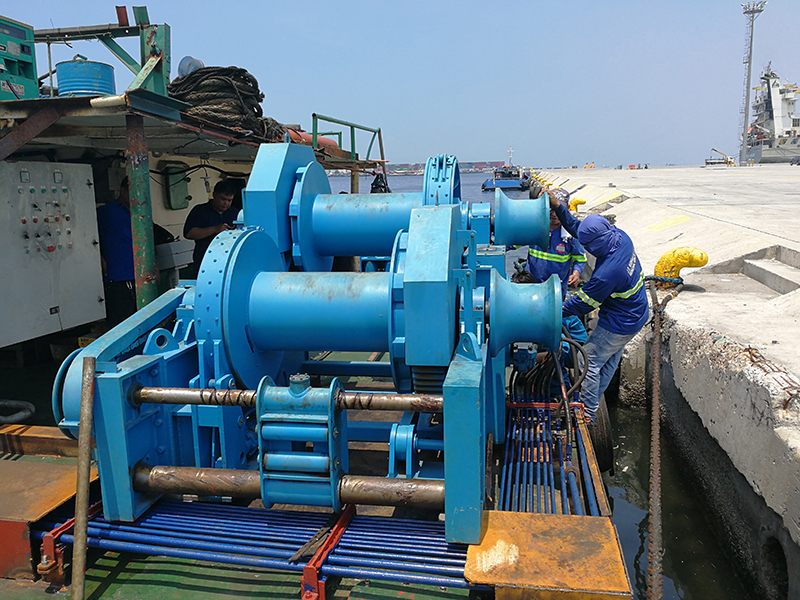Maintaining the hydraulic system of a 100 ton hydraulic winch is crucial for ensuring optimal performance, reliability, and longevity of the equipment. A hydraulic winch relies on hydraulic fluid, pumps, valves, hoses, cylinders, and other components to generate power and control the movement of loads. Regular maintenance practices help prevent hydraulic system failures, leaks, malfunctions, and costly repairs. Here’s a comprehensive guide on how to maintain the hydraulic system of a 100 ton hydraulic winch effectively:

Inspect Hydraulic Fluid
Start by inspecting the hydraulic fluid level and condition. Check the hydraulic reservoir or tank to ensure that the fluid level is within the recommended range indicated by the manufacturer. Monitor the color, clarity, and consistency of the hydraulic fluid. If the fluid appears cloudy, discolored, or contaminated with debris, water, or air bubbles, it may indicate the need for fluid replacement or filtration.
Change Hydraulic Fluid
Regularly change the hydraulic fluid at intervals recommended by the manufacturer or based on operating conditions. Drain the old hydraulic fluid from the reservoir, flush the system with clean fluid, and refill the reservoir with fresh, high-quality hydraulic fluid that meets the specifications and viscosity requirements of the hydraulic system. Use filters or strainers to remove contaminants during fluid replacement.
Check Hydraulic Hoses and Fittings
Inspect hydraulic hoses, fittings, and connections for signs of wear, leaks, cracks, or damage. Check for loose or damaged hose clamps, fittings, seals, or O-rings. Replace worn or damaged hoses, fittings, and seals with compatible replacements to prevent hydraulic fluid leaks and ensure proper hydraulic system operation.
Monitor Hydraulic Pressure
Monitor hydraulic pressure levels using pressure gauges or sensors installed in the hydraulic system. Check for fluctuations or abnormalities in hydraulic pressure during winch operation. Adjust pressure settings as needed within the recommended operating range to ensure smooth and efficient winch performance without overloading or damaging hydraulic components.
Inspect Hydraulic Pumps and Motors
Inspect hydraulic pumps, motors, and drive components for signs of wear, overheating, noise, or abnormal vibrations. Check for leaks around pump seals, gaskets, or shafts. Monitor pump and motor performance to ensure consistent power delivery and efficiency. Lubricate moving parts and bearings as recommended by the manufacturer.
Check Hydraulic Valves
Inspect hydraulic control valves, relief valves, check valves, and directional valves for proper functioning. Test valve operation during winch operation to ensure smooth and accurate control of hydraulic fluid flow, pressure, and direction. Clean or replace valves that are stuck, clogged, or malfunctioning to maintain hydraulic system integrity.
Clean Hydraulic Filters
Clean or replace hydraulic filters regularly to remove contaminants, dirt, and debris from the hydraulic fluid. Check suction filters, pressure filters, and return filters for clogging or restriction of flow. Clean or replace filter elements according to maintenance intervals or when pressure differentials indicate filter blockage. Use compatible filters with the correct micron rating for optimal filtration efficiency.

Inspect Hydraulic Cylinders
Inspect hydraulic cylinders, piston rods, seals, and rod bearings for leaks, scoring, corrosion, or damage. Check for smooth operation and proper alignment of cylinders during winch operation. Replace worn or damaged cylinder seals, rods, or bearings to prevent hydraulic fluid leaks, loss of power, or cylinder failure.
Grease Hydraulic Fittings
Grease hydraulic fittings, couplings, and pivot points to ensure smooth movement and reduce friction in hydraulic components. Use high-quality grease recommended for hydraulic applications and compatible with seals and O-rings. Apply grease at recommended intervals to prevent wear, corrosion, and premature failure of hydraulic system parts.
Perform Hydraulic System Tests
Conduct periodic hydraulic system tests and inspections to evaluate overall system performance, functionality, and safety. Test hydraulic system functions such as winch operation, load lifting, lowering, braking, and emergency shutdown procedures. Check for system leaks, abnormal noises, overheating, or malfunctions during testing. Record test results and address any issues identified promptly.
Train Operators and Maintenance Personnel
Provide training and education to operators and maintenance personnel on proper hydraulic system operation, maintenance, troubleshooting, and safety procedures. Train personnel on identifying hydraulic system issues, performing routine inspections, fluid checks, and maintenance tasks, and responding to hydraulic system emergencies or failures.
Keep Maintenance Records
Maintain detailed maintenance records, logs, and documentation for the hydraulic system of the 100 ton hydraulic winch. Record maintenance activities, inspections, fluid changes, component replacements, tests, and repairs. Keep track of maintenance schedules, service intervals, and warranty information for hydraulic system components.
By following these maintenance practices and guidelines, you can ensure the reliable performance, longevity, and safety of the hydraulic system in a 100 ton hydraulic winch. Regular maintenance helps prevent hydraulic system failures, optimize system efficiency, minimize downtime, and extend the lifespan of hydraulic components. Periodic inspections, fluid checks, component replacements, and testing are essential for maintaining peak hydraulic system performance and operational reliability.